NVIDIA GeForce GTX 670 Review Feat. EVGA: Bringing GK104 Down To $400
by Ryan Smith on May 10, 2012 9:00 AM ESTAs always, we’re wrapping up our look at a video card’s stock performance with a look at power, temperature, and noise. As GTX 670 is a lower clocked, lower power, harvested version of GK104, it should do even better than GTX 680 here. Remember, the power target for GTX 670 is only 141W.
| GeForce GTX 600 Series Voltages | |||||
| Ref GTX 670 Boost Load | EVGA GTX 670SC Boost Load | Ref GTX 680 Boost Load | Ref GTX 670 Idle | ||
| 1.175v | 1.162v | 1.175v | 0.987v | ||
Stopping to take a quick look at voltages, we find that NVIDIA hasn’t really adjusted the voltages of GTX 670 compared to GTX 680. Because GTX 670 has a lower maximum boost bin than GTX 680 it ramps up to 1.175v a bit sooner, but otherwise it’s still covering the same range of voltages as opposed to having a lower max voltage to further improve the power consumption. EVGA however does just that, topping out at 1.162v. They’ll need all the power savings they can get since power consumption is inversely proportional to performance under NVIDIA’s power target system.
On that note before we jump into our graphs we wanted to try something new: a look at the average core clockspeed during our benchmarks. Because of GPU boost the boost clock alone doesn’t give us the whole picture – particularly when also taking a look at factory overclocked cards – we’ve recorded the clockspeed of our GPU during each of our benchmarks when running them at 2560x1600 and computed the average clockspeed over the duration of the benchmark.
| GeForce GTX 670 Average Clockspeeds | ||||
| GTX 670 | EVGA GTX 670SC | |||
| Max Boost Clock | 1084MHz | 1188MHz | ||
| Crysis | 1057MHz | 1079MHz | ||
| Metro | 1042MHz | 1066MHz | ||
| DiRT 3 | 1037MHz | 1062MHz | ||
| Shogun 2 | 1064MHz | 1105MHz | ||
| Batman | 1042MHz | 1075 MHz | ||
| Portal 2 | 988MHz | 1034MHz | ||
| Battlefield 3 | 1055MHz | 1080MHz | ||
| Starcraft II | 1084MHz | 1129MHz | ||
| Skyrim | 1084MHz | 1113MHz | ||
| Civilization V | 1038MHz | 1073MHz | ||
| OCCT | 953MHz | 980MHz | ||
In spite of the GTX 670’s boost clock of only 980MHz, we see that it spends almost its entire time above that, and indeed spends its whole time above the base clock. As far as games go, with the exception of Portal 2 it’s always in the mid-1000s, whereas the GTX 680 was only a bit higher at the high 1000s. This is a big part of why the GTX 670 has performed so well in our tests: it may be rated lower, but in fact it can reach clockspeeds very close to the GTX 680.
At the same time this is why we see the EVGA GTX 670 Superclocked struggle to separate itself from the reference GTX 670, in spite of a 6%+ factory overclock. Too much of the time it’s simply not boosting much higher than the reference GTX 670, which limits the performance gains. With GPU Boost in effect this means there are a range of cards and we could be looking at a particularly good reference GTX 680, but whether that’s the case or not the end result is that EVGA’s card can’t do too much amidst the 141W power target limit.
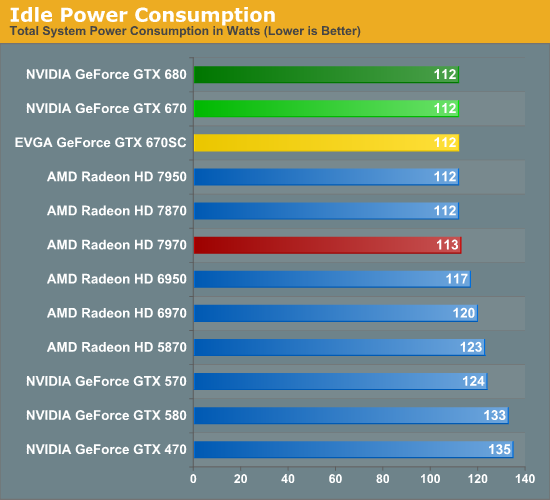
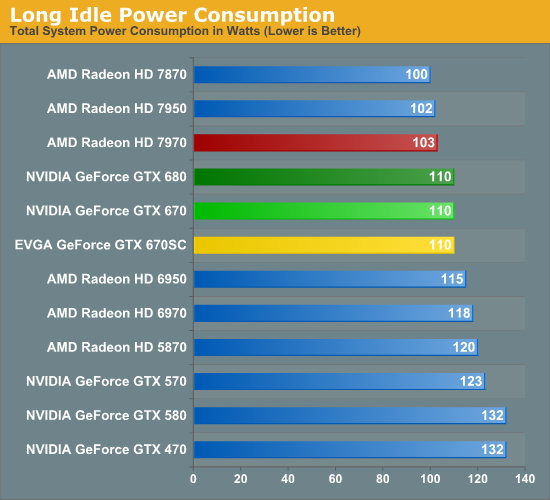
Starting with idle power, there aren’t any major surprised compared to the GTX 680. NVIDIA and AMD have both done such a good job managing their idle power consumption that even with the disabled SMX there’s no measurable difference between video cards. GTX 680 and GTX 670 effectively have the same idle and long idle power consumption.
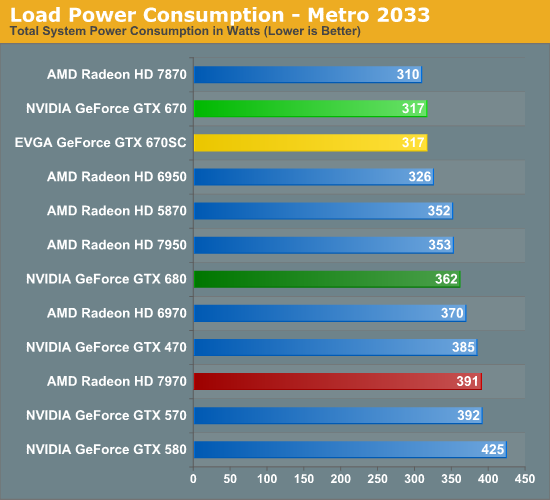
Moving on to load power consumption we can immediately see the GTX 670’s lower power target come into play. At 317W from the wall it’s 45W less than the GTX 680 for roughly 90% of the gaming performance, and this is in fact is lower power consumption than anything except the Radeon HD 7870. Even the GTX 560 Ti (which isn’t in this chart) is higher at 333W, reflecting the fact that GK104 is the true successor to GF114, and which would make GTX 670 the successor to GTX 560 from a design perspective.
Of course this also means that GTX 670 does very well for itself compared to AMD’s cards. We saw GTX 670 slightly outperform 7950 in Metro and here we see it drawing 36W less at the wall at the same time. Or compared to the 7970, 7970 can outperform GTX 670 by about 10%, but we’re drawing 74W more at the wall as a result.
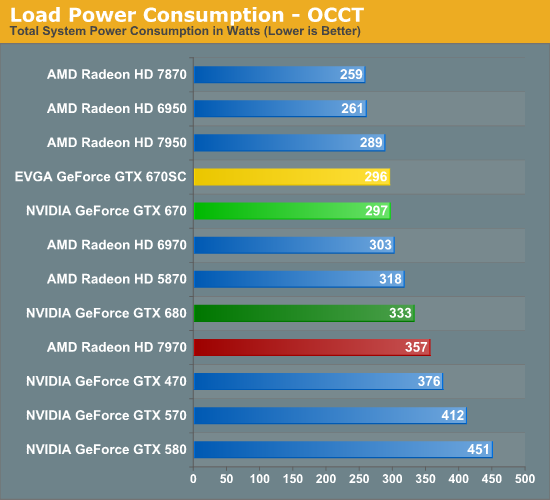
Relative power consumption shifts slightly under OCCT, but the story is otherwise similar. It’s not immediately clear why GTX 670’s power consumption is slightly higher than 7950 even after what we saw with Metro (PowerTune should be capping at 200W), but at least in this test the GTX 670 does end up doing a bit worse. On the other hand it’s still 60W less than the 7970.
Otherwise if we compare the GTX 670 to the GTX 680 we see that the GTX 680 ends up drawing 36W more at the wall, only a bit less than the difference we saw under Metro and quite close to what we’d expect based on the cards’ specifications.
On a related note, pay close attention to NVIDIA’s power target system in action here. In spite of the fact that the GTX 670SC is a binned part running at a lower voltage and higher clockspeeds, it’s drawing 1W less than the reference GTX 670. It would appear that NVIDIA has very good control over their power consumption overall, even if they can only adjust clocks for it a few times per second.
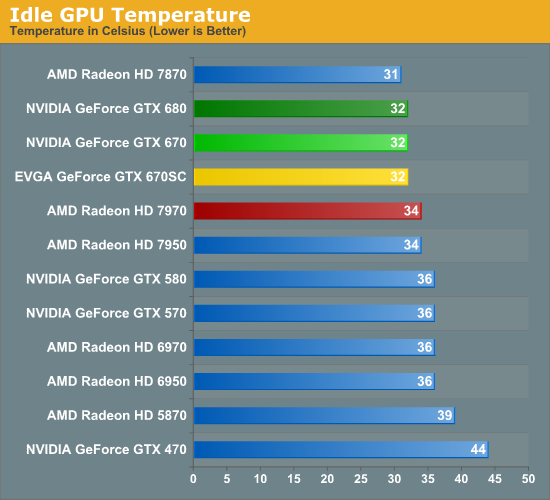
Seeing as how NVIDIA is using roughly the same cooler design with GTX 670 as they are with GTX 680 and they have the same idle power consumption, it should come as no surprise that temperatures are so similar. 32C is among the lowest of the temperatures we’ll see for a blower unless it’s running fast & loud.
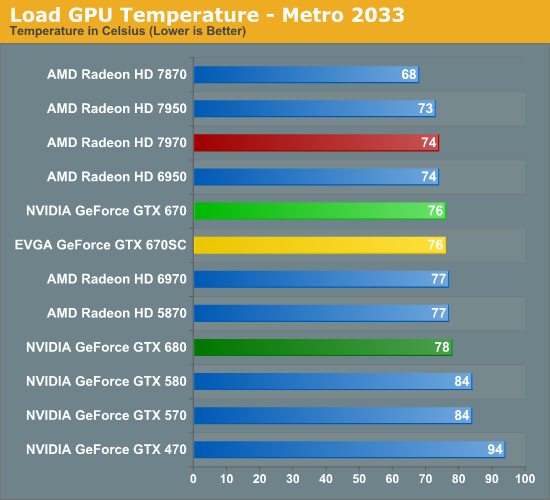
Thanks to the lower power consumption of the GTX 670 temperatures have gone down as well. 76C is still 2C warmer than the Radeon HD 7900 series due to AMD’s more aggressive cooler but it’s 2C cooler than the GTX 680. The thermal threshold for GK104 is 98C, which means there’s still over 20C of thermal headroom to play with here.

OCCT pushes temperatures up some, but not by much thanks to NVIDIA’s power target system. Since the GTX 680 tied the 7970 at 79C here, this means the GTX 670 is 2-3C cooler than both the GTX 680 and the 7970, and 0-1C warmer than the 7950.
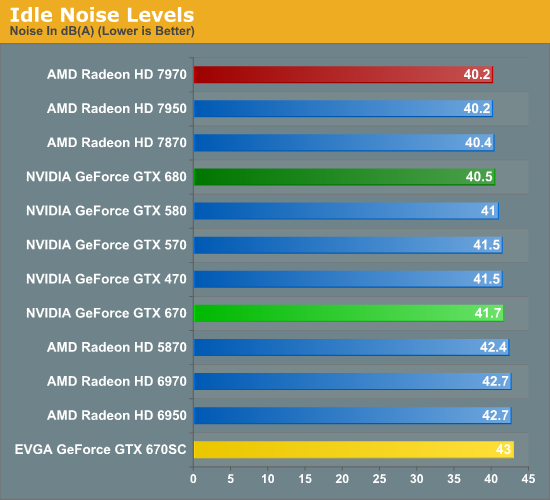
Unfortunately the impressiveness of the GTX 670 begins to wane some here at noise. NVIDIA tells us that the GTX 670 uses the same fan as the GTX 680 but this seems questionable. 41.7dB is not significantly louder than the GTX 680’s 40.5dB, but there’s a definite difference in pitch compared to the GTX 680. The GTX 670 seems to have a low pitch hum/grind to it that GTX 680 didn’t have.
Meanwhile EVGA’s card fares the worst here, at the precipice of falling out of the quiet zone. Since it’s using what’s fundamentally the same fan and cooler as the reference card, the only practical explanation is that EVGA’s smaller diameter fan intake has a negative impact on fan noise.
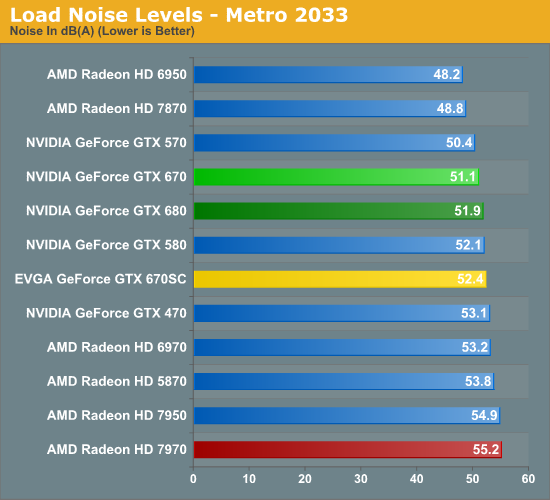
Finally, when looking at load noise we see that the GTX 670 doesn’t fare significantly better or worse than the GTX 680 here. At 0.8dB quieter than the GTX 680 the GTX 670 is a smidge quieter, but it’s nothing that’s particularly appreciable. Perhaps the more important fact is that this is 3.8dB quieter than the 7950 and 4.1dB quieter than the 7970, making the GTX 670 notable quieter than either 7900 series card. In practice the only place the GTX 670 loses is oddly enough to the GTX 570. The GTX 570 was 0.7dB quieter than the GTX 670 despite the former’s much higher power consumption. NVIDIA did let the GTX 570 get hotter than the GTX 670 so it looks like the GTX 670’s fan curve is a bit more aggressive than the GTX 570’s.
As for the EVGA GTX 670 Superclocked we’re seeing the same thing that we saw at idle: it’s just a bit louder than the reference GTX 670. This is in spite of the fact that the GTX 670SC’s fan actually went to the same speed as the reference GTX 670’s fan in this test.
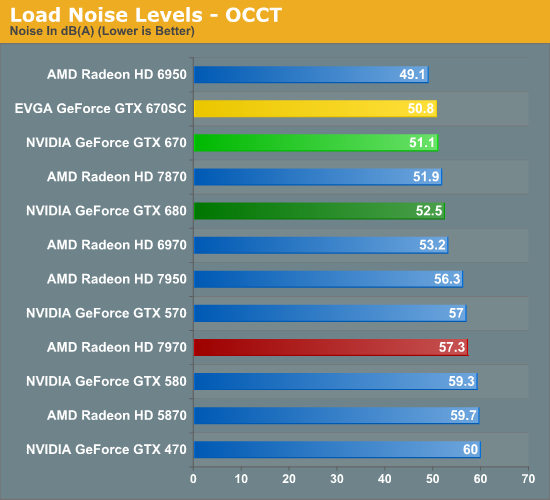
NVIDIA’s power target once more makes itself known here, thanks to which power consumption and thereby heat generation increases very little compared to what we saw under Metro. This widens the gap between the GTX 670 and 7900 series, which is now at 5.2dB and 6.2dB compared to the 7950 and 7970 respectively. Or compared to NVIDIA cards this is 1.4dB quieter than the GTX 680 and nearly 6dB quieter than the unthrottled GTX 570.
Meanwhile there’s something very interesting going on with the GTX 670SC that’s a wider reflection of the GTX 670’s reference fan. The fan speed went up but objective noise (A-weighted) went down. Why? That low-pitch hum we mentioned diminishes with a higher fan speed, and as a result the fan gets quieter once it passes a certain threshold. Subjectively we agree with our sound meter: the GTX 670SC sounds quieter here than it does as the lower fan speed it uses for cooling during Metro. We haven’t experienced anything like this with the GTX 680, which makes us further doubt that the fans are identical between the GTX 680 and GTX 670. Close no doubt, but not the same.
Wrapping things up this entire scenario is very similar to how we saw the launch of the GTX 680 play out. NVIDIA has a strong performing part with less noise and less power consumption than either its 500 series predecessors or AMD’s closest competition. This in turn was a big part of what made the GTX 680 so easy to recommend, as better performance with less noise is exactly the kind of direction we like to see video cards move in.










414 Comments
View All Comments
Gastec - Tuesday, November 13, 2012 - link
Insanity!CeriseCogburn - Friday, May 11, 2012 - link
When amd has trouble with a game, the reviewer, completely unaware of any amd deficiency (as any good fanboy), has no explanation at the ready, nothing he has been watching for as an identified weakness - unlike the nVidia cards, where the reviewer is on constant watch for what he believes are nVidia card weaknesses." Skyrim is a game that for inexplicable reasons AMD just has some trouble with that NVIDIA doesn’t, possibly driver overhead."
Yes, we know, if amd doesn't do well, it's inexplicable. Something just has to be wrong. Somehow reality has warped.
Then after noting the 670 win fairly, we get this:
" At 1920 we’re clearly CPU limited even with all of Skyrim’s graphical features turned up. "
Instead of saying the 570 beats every amd card at that resolution, or even noting every amd card is stacked at the bottom, period, it's a "cpu problem" - amd didn't fail, the cpu did...
That's not all - after seeing the 570 spank every amd card at the 1920 resolution the reviewer goes on attack, since he mentioned of course earlier in the article nVidia brought up the 570, meaning it would be part of their line up he said, so attacking it is a must, as any good fanboy knows. Never mention is has spanked the 7870 and 7850 and even the 7970 once (civ5) and never mention it spanks the whole amd tier in this game with texture packs and it's "puny memory" at 1920, but go after it...
" GTX 670 is greatly improving on the GTX 570 due to the latter’s lack of memory. 1.25GB is cutting it close here with the high resolution texture pack "
There you have it. Once again. The GTX570 spanks every amd card at 1920 but all it gets is a big fat cut down for 2560.
Oh yes, the whole way it's done is consistently against nVidia.
CeriseCogburn - Friday, May 11, 2012 - link
Here again, an nVidia win is inexplicable. Instead we hear about the amd "strength".When nVidia wins, remember it's unclear why because it should not be happening, amd has a superior strength !
" At this point it’s not entirely clear why the GTX 600 series does so well here (both AMD and NV use SGSSAA), especially given the fact that the Radeons have a memory bandwidth advantage."
Now we can listen to the "on paper" amd fanboys, and the endless fantasy that future drivers and future games mean amd is the "future winner" for the newest cards tested and compared.
Never will we hear the amd core "technology" is weaker and has some severe caveats when it comes to game engines and implementation.
Instead, that with much superior "paper horsepower" on "notional multiplications" based upon less than fully accurate simplified calculations omitting severe bottlenecks in amd architecture and adding in guesses for the "tricks" amd has to "overcome" them, we will always be told the above, instead of the truth.
AMD core design is inferior for most of the game engines.
snakefist - Friday, May 11, 2012 - link
" At this point it’s not entirely clear why the GTX 600 series does so well here (both AMD and NV use SGSSAA), especially given the fact that the Radeons have a memory bandwidth advantage."oh, dear god - as much as i try to ignore you...
do you, or do you not remember NVIDIA cards with 192/384/512 memory bandwidth and how much good this "advantage" brought to them? compared to AMD 128/256 bandwidth of the same generation?
when commenting your post, one is necessarily becoming an AMD fan, since basically everything you say is so biased and (mainly) incorrect or misinterpretation of actual facts
i suspect you secretly work for AMD :)
CeriseCogburn - Friday, May 11, 2012 - link
Are you aware the post you copied is the reviewers words, smarty pants ?Do you realize I was criticizing the reviewers words, his "bandwidth" notional advantage for amd ?
Do you realize you just called the reviewer and idiot and agreed with me ?
YOUR words > " do you, or do you not remember NVIDIA cards with 192/384/512 memory bandwidth and how much good this "advantage" brought to them? compared to AMD 128/256 bandwidth of the same generation?"
Now tell it to the reviewer dumb dumb, since you copied and pasted HIS WORDS from my post, his words, words for word from the review !
ROFLMAO - yes you maybe should become a paid operative for amd, you have the intelligence for it - get everything wrong then attack - you're perfect for them :)
snakefist - Friday, May 11, 2012 - link
nope. i do not realize that. i don't memorize each word of review to be able to write 2/3 comments of 22-pages thread...and i didn't call anyone "an idiot".
what i said is what i believe (furthermore, it could be backed up by numerous reviews from that time - all of them also written by reviewers, perhaps on your surprise). whether this reviewer agrees with me or not on this topic is a simple matter of opinions, and review itself doesn't burst with hate as all your posts do.
CeriseCogburn - Friday, May 11, 2012 - link
Who knows what you said, it isn't clear, because you didn't make it clear.Believe whatever it is you believe,as that is also unclear, and only your opinion, since no facts are present for you, according to you.
Of course you only see hate from me, since I point out the amd flaws, and amd is your fanboy fave, as your other posts clearly show, and no you don't sense hate from the reviewer as he coddles amd, as I pointed out, and that gives you a nice warm feeling of "good opinion" vibrations.
ROFL
It's all too clear.
CeriseCogburn - Friday, May 11, 2012 - link
PS- you called me a lot worse than an idiot, so don't cop out on your hate filled spewing. Of course who expects anything less from an amd fanboy.Let's go with this, so you don't forget, or try to claim white snowy innocence - I certainly hope a bunch of obvious amd fanboys ignore every fact and facet I've presented, and dive, "driven" as you noted, right (back) into their beloved failure, with someone like you doing that, I couldn't receive any greater and lovely reward for my efforts here.
snakefist - Friday, May 11, 2012 - link
i did question your sanity, which i found more than ever a reasonable question. i'm surely not only one who shares this doubt. as for anger-management - i don't find this insulting, you should rather stop living in denial that you have onei did not called reviewer "an idiot", which you implied.
i was not aware that you are making efforts of any kind, except to comment every sensible post of any author with your irrelevant raging about something else... now that you explained it so well, i'll probably stay off your noble crusade of enlightening people with wildly subjective and/or incorrect claims... at least as long i feel like it
facts behind my claims are clearly stated and usually well-known and proven. your last two posts doesn't have single fact, btw
now reap the benefits of your great reward, whatever you might think it is
CeriseCogburn - Saturday, May 12, 2012 - link
Oh stop being a liar, you got outed so now you can't stand yourself.Let's go with near page one where one of your fellow amd fans haphazardly claims the 365mm die of the amd card is so close to the 300mm die of the nVidia card that amd price dropping again is no problem.
Another amd snake applauded the post for the sanity it contained. ( merely because amd fanboyism was served well, of course)
I had to point out, with considerable effort and for the greater good ...
(let's face it amd fans should be ponying up profit dollars for the hurting amd, not demanding low prices be lowered again - it's called putting your money where your mouth is, and where your heart is in this case, something the amd zealouts apparently have, to only their personal and selfish advantage, trained themselves out of - a rude, and debilitating issue for amd - who IMO has greatly encouraged that suicidal behavior )
...that the 365mm die is over 43% larger than the 300mm die.
Now there's just a single example of what needs to happen much more often, so that we can be well informed persons instead of lying brainwashed monkeys.
I certainly do not mind a big 'ol fanboy, in fact that's great, but let's bring it up to a level where a fan can be a self respecting and respected addition, not in need of constant lies, and endless unethical misconduct, right ?
A fanboy should easily support his view with the truth and not be in need of anything other, and as I fairly point out, an honorable fanboy won't be hellbent on squeezing every last dollar from their favorite producer while at the same time preaching corporate profitability "lessons" or sideway gloatings of the same, in direct opposition to their stated personal savings conduct goal and oft lofted talking point rhetoric.